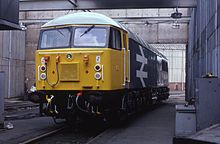BR class 56
| BR Class 56 | |
|---|---|
|
Class 56 locomotive in freight train service (1986)
|
|
| Numbering: | 56001 - 56135 |
| Number: | 135 |
| Manufacturer: | Brush Electrical Machines, Electroputere , British Rail Engineering |
| Year of construction (s): | 1976-1984 |
| Retirement: | 2004 ( EWS ) |
| Axis formula : | Co'Co ' |
| Gauge : | 1435 mm ( standard gauge ) |
| Length: | 19,350 mm |
| Height: | 3,890 mm |
| Width: | 2,790 mm |
| Service mass: | 125 t |
| Top speed: | 130 km / h |
| Short term output: | 2,625 kW |
| Hourly output : | 2,425 kW |
| Starting tractive effort: | 275 kN |
| Continuous tensile force: | 240 kN |
| Braking force: | 588 kN |
| Tank capacity: | 5,228 l |
| Number of traction motors: | 6th |
| Train heating: | unavailable |
The BR Class 56 is a UK- based range of diesel-electric locomotives for use on freight trains , developed by Brush Electrical Machines and manufactured between 1976 and 1984.
history
development
The traction change from steam to diesel was completed at British Rail with the full commissioning of Class 47 in 1968. Over 500 units of the class 47 were produced, so that there was initially no need for further locomotives. When the oil crisis loomed in 1973 , British Rail registered a sharp increase in the volume of coal transport that could not be managed with the class 47 locomotives, which had a rather low output of 1,925 kW for heavy coal trains and in some cases did not allow multiple traction. British Rail considered an in-house construction for a short time, but in order to keep the time to normal operation as short as possible, it was decided to place an order with Brush Electrical Machines in Loughborough . Due to the lack of capacity at the Brush works in Loughborough, only individual parts of the locomotives were manufactured there. The final assembly took place at Electroputere in Romania. However, the first of the machines delivered had manufacturing defects and appeared to be unreliable in everyday use. British Rail therefore decided against continuing this production method; the final assembly took place from the 31st locomotive at the Doncaster plant of the BR subsidiary British Rail Engineering . The last 20 of the 135 Class 56 locomotives were manufactured by British Rail in Crewe . An option for additional locomotives was not exercised; instead, the simpler, but more cost-effective class 58 was built .
business
After eliminating initial errors, the class 56 locomotives ran relatively reliably. In the early days, it was mainly used in front of heavy steel and coal trains in Wales and northern England , with Class 47, which was instead used in front of passenger trains, and Class 20, which only had 750 kW of power, were adopted. When the class 60 appeared in 1989, 100 of which were produced, the class 56 machines switched to the lighter freight train service. In 1998 the class 66 was launched by General Motors. This locomotive replaced the less efficient Class 56 in numerous transport companies in which British Rail was absorbed in the course of privatization ; within a short period of time, more than half of the stock was shut down. Even if some machines could be reactivated for a short time through sales, the number of active class 56 locomotives fell to 25 by 2003, mainly for the English, Welsh & Scottish Railway . Due to restructuring measures within this railway company, the use of the last class 56 machines ended in March 2004.
The regular use of the machines ended after a relatively short period of 20 to 25 years for locomotives. Accordingly, quite a few locomotives, instead of being dismantled, were simply parked on sidings so that reactivations were possible. Among other things, these were used as construction train locomotives for the realization of the LGV Est européenne in France . A total of 30 locomotives were transferred through the Eurotunnel for this measure , which returned to the United Kingdom after the high-speed line was completed. Some smaller railroad companies reactivated individual Class 56 machines, including Fastline and Colas Rail . A single-digit number of locomotives are still in use today.
Three machines have been preserved as a museum and are used in front of special trains.
technology
The frame and locomotive body of the BR class 56 together form the load-bearing elements of the locomotive. This leads to a favorable weight distribution, but repairs after minor accidents therefore took a relatively long time.
The Class 56 diesel generator was manufactured by English Electric . Generators of a similar type were installed in diesel locomotives for shunting service before the start of the Second World War ; for use in mainline locomotives, the output was increased to 1,190 kW in 1947. By 1973, English Electric succeeded in increasing the output of the 16-cylinder unit to 2,625 kW, but in order to increase the service life, British Rail throttled the output that could be achieved during operation to 2,425 kW.
Web links
Individual evidence
- ^ A b c d Brian Hollingsworth, Arthur F. Cook: Das Handbuch der Lokomotiven , Weltbild Verlag, Augsburg 1996, ISBN 3-86047-138-4 , p. 398f.
- ↑ a b c d History of Class 56 ( Memento of February 16, 2012 in the Internet Archive ) on class56group.co.uk , accessed on January 11, 2020.



